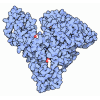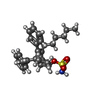Entry Database : PDB / ID : 6oqxTitle Human Liver Receptor Homolog-1 bound to the agonist 5N and a fragment of the Tif2 coregulator Nuclear receptor coactivator 2 Nuclear receptor subfamily 5 group A member 2 Keywords / / Function / homology Function Domain/homology Component
/ / / / / / / / / / / / / / / / / / / / / / / / / / / / / / / / / / / / / / / / / / / / / / / / / / / / / / / / / / / / / / / / / / / / / / / / / / / / / / / / / / / / / / / / / / / / / / / / / / / / / / / / / / / / / / / / / / / / / / / / / / / / / / / / / / / / / / / / / / / / / / / / / / / / / / / / / / / / / / / Biological species Homo sapiens (human)Method / / / Resolution : 2.004 Å Authors Mays, S.G. / Ortlund, E.A. Funding support Organization Grant number Country National Institutes of Health/National Institute of Diabetes and Digestive and Kidney Disease (NIH/NIDDK) R01DK095750 National Institutes of Health/National Institute of Diabetes and Digestive and Kidney Disease (NIH/NIDDK) R01DK114213 National Institutes of Health/National Institute of Diabetes and Digestive and Kidney Disease (NIH/NIDDK) F31DK111171 National Institutes of Health/National Institute of General Medical Sciences (NIH/NIGMS) T32GM008602
Journal : J.Med.Chem. / Year : 2019Title : Development of the First Low Nanomolar Liver Receptor Homolog-1 Agonist through Structure-guided Design.Authors : Mays, S.G. / Flynn, A.R. / Cornelison, J.L. / Okafor, C.D. / Wang, H. / Wang, G. / Huang, X. / Donaldson, H.N. / Millings, E.J. / Polavarapu, R. / Moore, D.D. / Calvert, J.W. / Jui, N.T. / Ortlund, E.A. History Deposition Apr 29, 2019 Deposition site / Processing site Revision 1.0 Aug 28, 2019 Provider / Type Revision 1.1 Dec 25, 2019 Group / Category / Item Revision 1.2 Jan 8, 2020 Group / Category / citation_authorItem _citation.journal_volume / _citation.page_first ... _citation.journal_volume / _citation.page_first / _citation.page_last / _citation.title / _citation_author.name Revision 1.3 Oct 11, 2023 Group / Database references / Refinement descriptionCategory chem_comp_atom / chem_comp_bond ... chem_comp_atom / chem_comp_bond / database_2 / pdbx_initial_refinement_model Item / _database_2.pdbx_database_accession
Show all Show less
 Yorodumi
Yorodumi Open data
Open data Basic information
Basic information Components
Components Keywords
Keywords Function and homology information
Function and homology information Homo sapiens (human)
Homo sapiens (human) X-RAY DIFFRACTION /
X-RAY DIFFRACTION /  SYNCHROTRON /
SYNCHROTRON /  MOLECULAR REPLACEMENT / Resolution: 2.004 Å
MOLECULAR REPLACEMENT / Resolution: 2.004 Å  Authors
Authors United States, 4items
United States, 4items  Citation
Citation Journal: J.Med.Chem. / Year: 2019
Journal: J.Med.Chem. / Year: 2019 Structure visualization
Structure visualization Molmil
Molmil Jmol/JSmol
Jmol/JSmol Downloads & links
Downloads & links Download
Download 6oqx.cif.gz
6oqx.cif.gz PDBx/mmCIF format
PDBx/mmCIF format pdb6oqx.ent.gz
pdb6oqx.ent.gz PDB format
PDB format 6oqx.json.gz
6oqx.json.gz PDBx/mmJSON format
PDBx/mmJSON format Other downloads
Other downloads 6oqx_validation.pdf.gz
6oqx_validation.pdf.gz wwPDB validaton report
wwPDB validaton report 6oqx_full_validation.pdf.gz
6oqx_full_validation.pdf.gz 6oqx_validation.xml.gz
6oqx_validation.xml.gz 6oqx_validation.cif.gz
6oqx_validation.cif.gz https://data.pdbj.org/pub/pdb/validation_reports/oq/6oqx
https://data.pdbj.org/pub/pdb/validation_reports/oq/6oqx ftp://data.pdbj.org/pub/pdb/validation_reports/oq/6oqx
ftp://data.pdbj.org/pub/pdb/validation_reports/oq/6oqx


 Links
Links Assembly
Assembly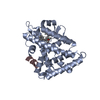
 Components
Components Homo sapiens (human) / Gene: NR5A2, B1F, CPF, FTF / Production host:
Homo sapiens (human) / Gene: NR5A2, B1F, CPF, FTF / Production host: 
 Homo sapiens (human) / References: UniProt: Q15596
Homo sapiens (human) / References: UniProt: Q15596 X-RAY DIFFRACTION / Number of used crystals: 1
X-RAY DIFFRACTION / Number of used crystals: 1  Sample preparation
Sample preparation SYNCHROTRON / Site:
SYNCHROTRON / Site:  APS
APS  / Beamline: 22-ID / Wavelength: 1 Å
/ Beamline: 22-ID / Wavelength: 1 Å Processing
Processing MOLECULAR REPLACEMENT
MOLECULAR REPLACEMENT Movie
Movie Controller
Controller


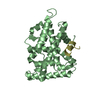
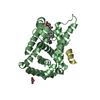


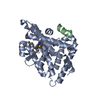
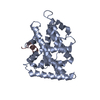
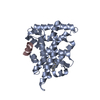
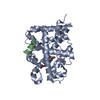
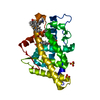

 PDBj
PDBj






